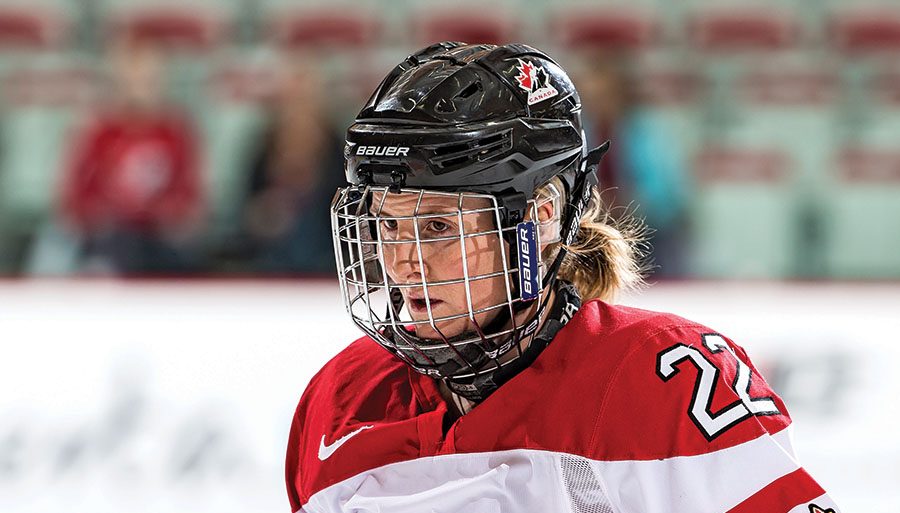
In conversation with Hayley Wickenheiser
By Jeremy Finkelstein
(Originally appeared in the Winter 2018 of The Collection)
The Olympic Games represent the pinnacle of athletic competition, putting the world’s greatest athletes centre stage for a 16-day spectacle unmatched by any other international competition. This February, PyeongChang, South Korea will host the 23rd Winter Games, and for the first time since 1994, Canada’s Hayley Wickenheiser will find herself enjoying the experience just like the rest of us…as a spectator.
With four gold medals and a silver in five Olympic appearances playing for Canada’s National Women’s Hockey Team, she is one of the most decorated athletes of all time and widely considered the world’s best female hockey player. In 2017, with an all-but-certain sixth medal on the horizon, Wickenheiser decided to hang up her skates to pursue other interests. To no one’s surprise, she’s tackling post-hockey life with the same ‘raise the bar’ gusto that defined her playing career. Her company, Wick Hockey, is working to expand the game of hockey internationally, while her annual charitable tournament, WickFest, brings girls from around the world to Calgary to participate in a tournament and a series of workshops and clinics. Off the ice, she will be pursuing a medical degree, and she sits on the advisory board for Highmark Interactive, a tech company creating programs to assist in concussion recovery.
The Collection sat down with the future hall-of-famer to talk WickFest, the Olympic Games, and the evolution of women’s hockey.
THE COLLECTION: How has hockey changed for girls since you first started out in the early ‘80s?
HAYLEY WICKENHEISER: It’s changed a lot. Everything is more advanced from when I was playing with the boys. Today, in minor hockey there are more girls. At the National Team level, the girls are getting the opportunity to play internationally, younger. There’s an under 18, and an under 22, and a National Team. That wasn’t the case when I started playing. There are more opportunities and better resources for the kids…Everything is more professional.
TC: Following the announcement of your retirement, Edmonton Oilers’ CEO Bob Nicholson said that despite all the on-ice moments, “your biggest memory will be how you inspired so many girls to play the game.” What does it mean to you knowing that you played a significant role in that growth?
HW: Well, I think I probably did that with the help of a lot of other women that came at the same time or came before and inspired me. I think that when you play on the National Team, there is a responsibility to carry the mantle forward for the women who played before you and the women that will play after you. You are a role model, and it’s an honour to wear that jersey and to have those responsibilities. Young kids are watching and looking up and I take that very seriously.
TC: Is enough being done today to make hockey accessible to girls in Canada?
HW: It’s come a long way but we could always do more to make it better. I’m proud of what we’ve done with my festival, WickFest. It’s not just a hockey tournament; it’s a professional development festival for girls and women from around the world. We have teams from China, Mexico, the Czech Republic, and Finland. We’re looking into bringing the Indian team over next year. We’re doing a lot in Canada and the US but more needs to be done internationally.
[This year], WickFest has 7,000 people from around the world. The girls get five games but they also get to sign up for off-ice sessions. Last year, we had seven Olympic gold medalists involved. We bring in the NHL…people like Brian Burke and Trevor Linden…experts in nutrition, mental health, and education. And it’s a totally not for profit event. All the proceeds go to Right to Play and Jump Start.
TC: And, you’ll be awarding some of the participants with $5,000 scholarships through the Lace’Em Up Foundation.
HW: The Lace’Em Up Foundation is a great donor of ours, and a not for profit foundation, which is giving 10 girls $5,000 to pursue a post-secondary education. They will have to have had hockey as a part of their lives growing up. We were just making those calls and hearing the excitement in the girls’ voices…it’s pretty cool.
TC: Outside of WickFest, your company, Wick Hockey, is also bringing hockey to countries around the world that wouldn’t normally get exposure: India, Kazakhstan, China, Mexico, Ireland. How is the initiative doing?
HW: We did two camps in China in the summertime led by Danielle Goyette, who was just inducted into the Hockey Hall of Fame. We are working on a project to go to India and other countries to work with boys and girls in hockey development. It’s a cool initiative that’s fun to work on.
Hockey is a game for everyone but it’s an expensive game and it’s a geographically isolated game. If we can open new markets and expose more people to hockey, it helps build growth in everyone. We can teach a lot of values and goodwill through sports that you can’t get in other realms of life.
TC: Off the ice, you co-chair an advisory committee for Highmark Interactive, a company working to create tools to help athletes recover from concussions. Please explain your work with video game technology to treat concussions?
HW: The old way of thinking about concussions is that you go and sit in a dark room and don’t do anything. But, the research shows us that light activity, in returning to normal, baseline daily activities is really important. It actually helps the brain recover. At Highmark, we’re creating interactive technologies through video games for kids to aid them in their baseline recovery from a concussion. It’s not a way to cure or fix a concussion, but it’s another tool in the toolbox that can help with recovery and education. Video games are a great medium to use. Because kids are on devices so often, it’s an effective way to get to a population that might not otherwise have that information.
TC: You’re pursuing a degree in medicine. Will head trauma be a focus of your studies?
HW: For sure. I’m very passionate about concussions. I lost one of my best friends, Steve Montador, I think as a result of head trauma throughout his entire career…so when I do start medicine, it will be a big focus of mine.
TC: Don Cherry has encouraged kids to play hockey with a long stick, saying those who play with a short stick are leaning over all the time. He even blamed short sticks on Eric Lindros’ concussion troubles.
HW: He makes a good point. I would say it depends upon the position. As a defenseman, you want a longer stick, forwards maybe not, depends on what kind of player you are…but I know what he’s getting at. Keep your head up. Play with your head up and play aware. That’s a really good thing. With head injuries, I would add that girls are more prone to concussion than boys for a variety of reasons, and there are actually more concussions in girls’ hockey than boys, despite the fact that there is no body-checking. I think that’s because there is no hitting in female hockey, so girls tend to play with their heads down. If there’s one thing we can do to encourage coaches and people involved in the female game, it’s to keep harping on keeping your head up because it will keep you out of a lot of trouble.
TC: You were the flag-bearer at the 2014 Sochi Games. Not many of us will ever share that experience. Can you describe what it’s like?
HW: It goes by really fast. I remember talking to Clara Hughes and asking her for advice. She and Catriona Le May Doan both carried the flag for Canada, and they both said, “Whatever you do, don’t let it hit the ground. Wave it high and wave it proudly.”
You used to be able to walk an entire lap around the stadium with the flag, but they changed the format, and so the flag-bearer just goes about 200 metres. Before you blink it’s over. I just remember looking into the crowd, and I noticed how many Canadian flags and how many Canadian fans were there. It was a very proud moment, and I remember thinking that we’re walking out representing Canada, and there’s no bigger honour and no better feeling than being a Canadian athlete. I’m very, very proud to be a Canadian.
TC: What is the pressure like for an athlete at an Olympics tournament versus another international competition?
HW: The Olympics is the pinnacle, especially in women’s hockey. It’s like our Stanley Cup. Many athletes go to the Olympics and think that they need to raise the bar to a higher level than they’ve ever competed at before. But really, if you train and perform every single day with the bar raised, when you get to the Olympics, it’s actually about resting, controlling your energy, and just going out and doing what you do. And that’s why the Games are so unique. In the Olympics, we see people choke, we see people rise up and do things that you never thought possible, and it tugs at the inner-most, primitive human spirit that we have. So, it’s a huge stage to be on, and when athletes are competing, it shows the best of us…the best of human values and humankind.
TC: How do you like the team’s chances this year, and who’s our biggest competition?
HW: Canada and the US will come down to a dogfight, and whoever is going to show up on that given day is going to be the winner. It’s like usual, flip a coin, hope for the best…but I put my money on Canada. They can pull it off.
TC: Are there any athletes you think audiences should pay close attention to on the Canadian team?
HW: We have the best goaltending in the world, and so that’s something that’s going to be a very important piece for Canada winning a gold medal. There’s a good core of players that were there in 2014, and there will be some young kids, but I don’t know what the team will look like yet because they haven’t named it. Defensively, they’ll have to be really good and then score on their opportunities.
TC: Why did you decide to retire so close to the next Olympic Games?
HW: There were a lot of different factors but it mainly came down to my opportunity to go to medical school, and other things I’m wanting to do in my life. I just had to make a decision…I’d been thinking about it for awhile, and everything kind of just seemed to come at once.
TC: What do you think it will be like watching the Games as a spectator?
HW: It will probably be very weird. I’m sure it will be much more enjoyable to watch than to be playing in it under all that pressure. So, I’ll probably just be able to sit back and enjoy it for once. I actually haven’t watched since 1998 when I first competed. I’ll be at the Olympics as a member of the IOC Athlete’s Commission, so I’ll go to different events and that will be a unique experience because usually, you don’t see anything.
TC: The post-career life of a female hockey player is significantly different than that of your male counterparts, given the financial discrepancy. Is Canada doing enough to support its female athletes when their playing days are over?
HW: No…probably not, but I will say that it’s much better than likely any other sport in this country, so I don’t think we can complain. I played 23 years and my pension was very small when I retired. And that’s ok, I didn’t play for the money. No one does. I think the important thing for a female hockey player is that when you start your career, you’re also thinking about the end of your career, because you know you’re going to have to live and make money. For a lot of male players, that’s not the case. So, I think what happens with the female athletes is that they come out of the sport a little bit better prepared for life after [hockey] and are overall a little bit healthier.
TC: What do you see as the next step in the evolution of women’s hockey?
HW: I think professional hockey. Now, we have two leagues…The Canadian Women’s Hockey League and the National Women’s Hockey League, and the best players in the world don’t all play in one league. This is only hurting the game, so those two leagues and their commissioners need to get together and figure it out so that they can take the game to another level.
TC: As you mentioned, Danielle Goyette was inducted into the Hockey Hall of Fame. Can you describe her impact on you as a player and her contribution to the game?
HW: I played with Danielle as my linemate for 10-plus years, so we know each other very well. I also played under her at the University of Calgary for four years; she was my coach, and in Sochi, she was our assistant coach, so I know her on every level. She’s probably the most skilled player I’ve ever played with. She’s an incredibly gifted athlete with natural talent, beautiful skating, great hands, and a true hockey IQ. That’s why she’s a good coach. I’m really happy for her; it’s totally well-deserved, and likely should have happened years ago, but she’s in there now with the best of the best. And she’s the fourth woman, so that’s pretty awesome for women’s hockey, too.
TC: And to be inducted at the same time as Dave Andreychuk, Teemu Selanne and Paul Kariya must be incredibly vindicating for you, as a female athlete.
HW: Yes, I’m very proud of the women that I’ve played with over the years and the women who have been inducted. Angela James…I played with her, too. She was my first linemate, and when I started on the National Team, I was her winger. It shows the game has gotten more respect and has come a long way, but it still has a long way to go.
TC: Do you have advice for the next generation of Canadian athletes looking to pursue the sport?
HW: I would just say, keep raising the bar. If you love the game and you want to be great at it, whether you’re a boy or a girl, it’s about playing when no one’s watching, watching the best players in the world, and really loving what you do. For young girls, keep pushing for more, and keep fighting for your place in the game.
Photo Credit: Dave Holland/ Hockey Canada Images




